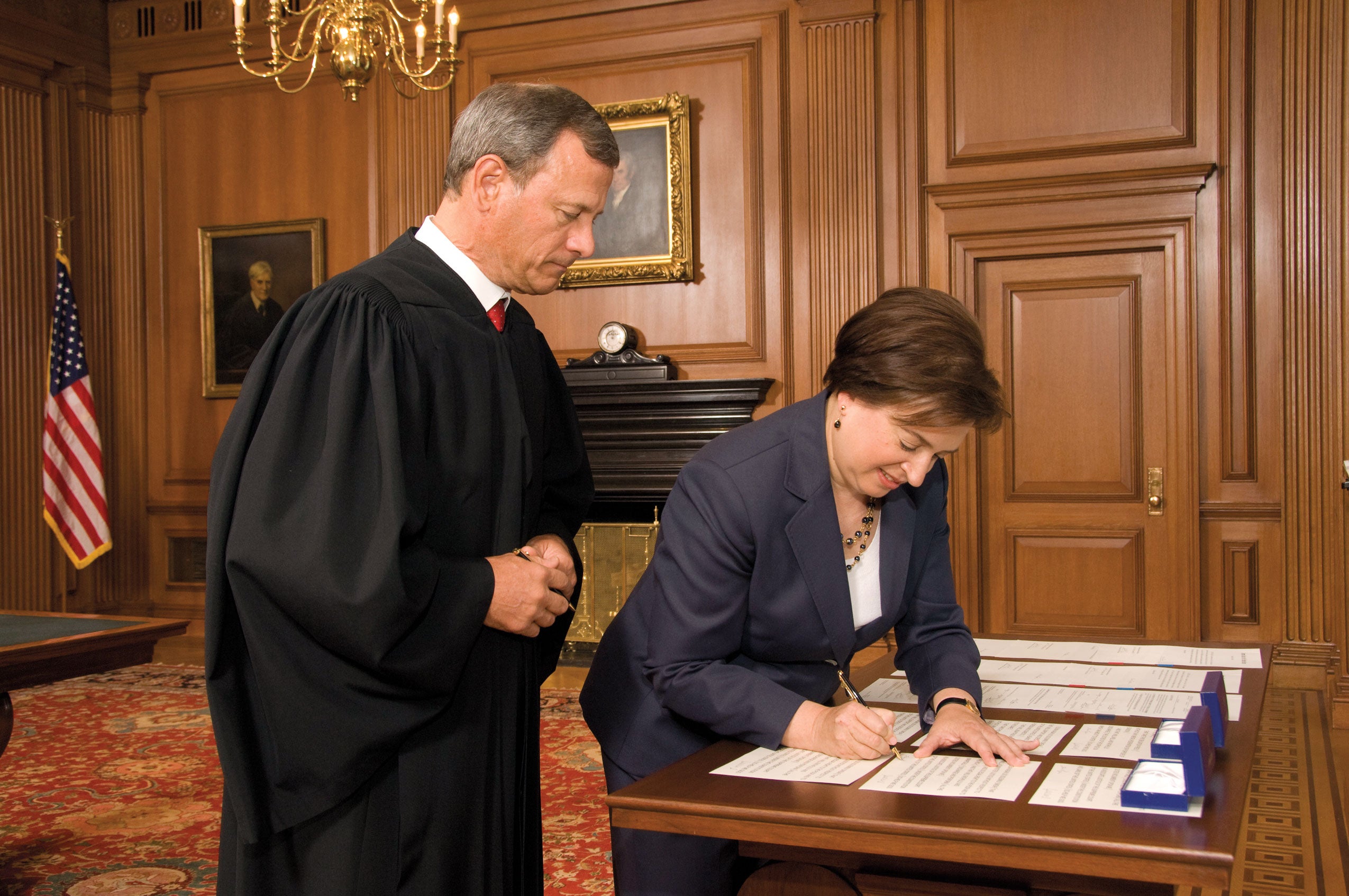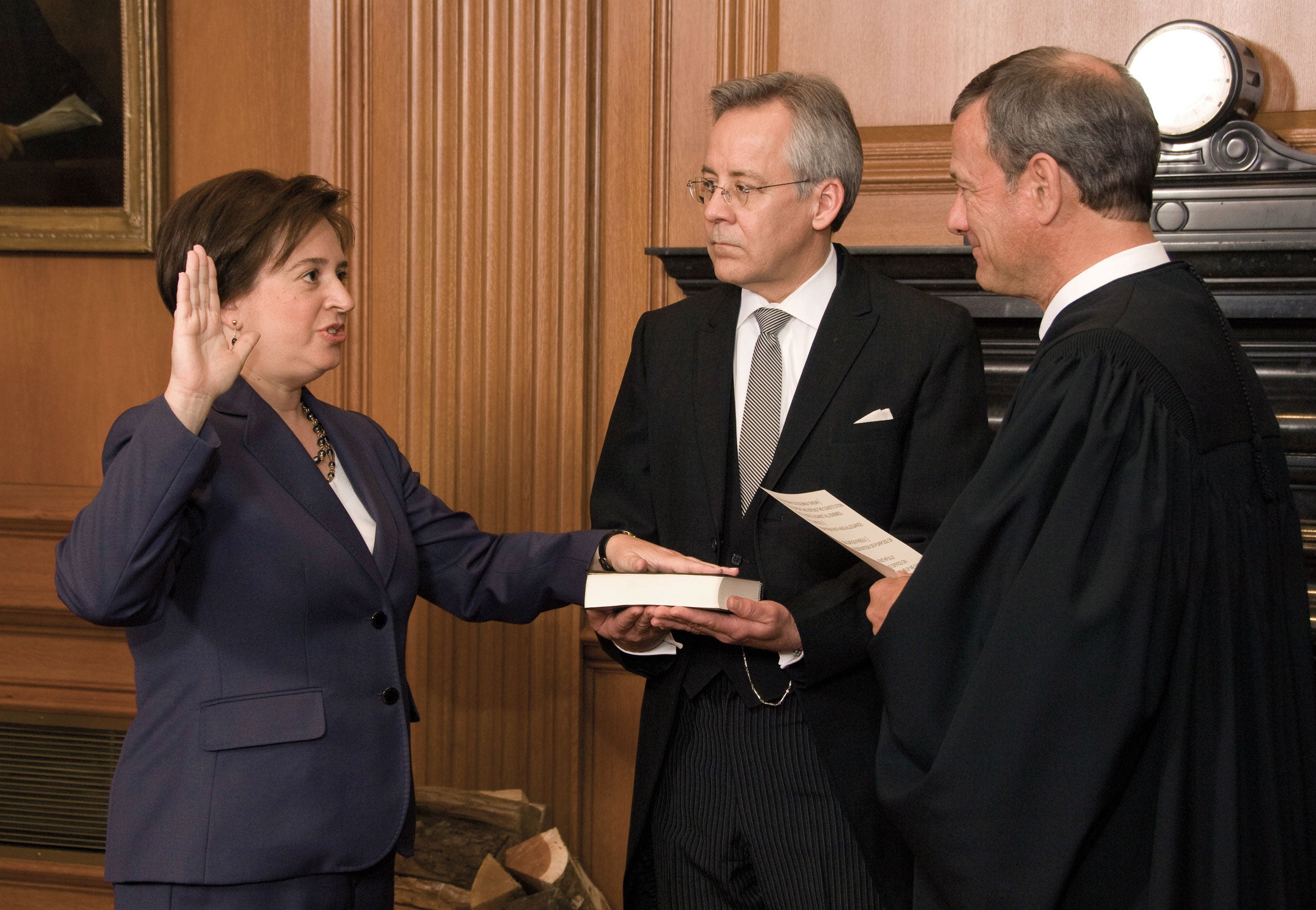As Harvard Law School’s first female dean and the first woman ever to serve as U.S. solicitor general, Elena Kagan ’86 has made a habit of making history.
On Oct. 1, Kagan sat on the far right-hand side of the Supreme Court’s courtroom in a chair first used by Chief Justice John Marshall, poised to make history once again at her formal investiture ceremony.
Kagan had already been a justice for almost two months by then, having taken the constitutional oath on Aug. 7 from Chief Justice John G. Roberts Jr. ’79. Five days before the investiture ceremony, she had attended her first conference—in which the justices met privately to discuss all the cert petitions that had piled up over the summer.
In a sense, the investiture was her public debut in her new role, one witnessed by all three retired justices as well as a trio of Democratic senators who had helped shepherd her nomination, and President Barack Obama ’91, who had tapped her for the Court five months earlier.
After the clerk of the Court read her commission, Kagan left the audience behind for the last time and ascended to the center of the bench. Roberts administered the judicial oath as her seven colleagues stood facing her. Then Kagan finally took her seat—bringing the number of sitting justices who attended HLS to six.

The robe Kagan wore that day was a gift from some of her former colleagues on the Harvard Law faculty. More than a dozen of them—including Carol Steiker ’86, Laurence Tribe ’66, Elizabeth Warren and Robert Clark ’72—sat in the audience, as was the case nearly every step along the way in her rapid elevation from solicitor general. (At that confirmation hearing last year, Kagan noted she had “brought a little bit of family from Cambridge” as she introduced the half dozen faculty members seated behind her.)
[pull-quote content=”There was nothing like…Seeing the complete court with its newest member.” float=”right”]
Her Harvard colleagues were there again on May 10 when Obama announced Kagan’s nomination to succeed John Paul Stevens, the Court’s longest serving member, at a White House ceremony. And they were there throughout Kagan’s three-day appearance before the Senate Judiciary Committee.
Confirmation hearings, like most aspects of the nomination process, have become carefully scripted affairs, where nominees have little to gain from revealing too much about themselves. But Steiker, who has known Kagan since they were second-year law students, said she was struck by how the person she knew shined through.
“I thought she was remarkably forthcoming and natural and funny,” said Steiker. “You could see the teacher in her in her explanations about constitutional interpretation and the ways the Constitution changes and doesn’t change over time. And you could see the person she was through her humor and her willingness to defuse tense moments with humor.”

In her opening statement, Kagan assured senators that “the Court must also recognize the limits on itself and respect the choices made by the American people.” She elicited laughs from both sides of the aisle in response to a question from Lindsey Graham (R-S.C.) about where she was at the time of a thwarted airline bombing last Christmas.
“Like all Jews, I was probably at a Chinese restaurant,” Kagan said.
Kagan’s tenure as Harvard Law School’s dean—and the scope of access she provided to military recruiters to campus—became a focus of the hearings.
HLS Lecturer Tom Goldstein, the Supreme Court litigator and editor of SCOTUSblog.com, who has attended six confirmations, said it was a predictable focus of attention in “this era where conservatives care so much about respect for the military, and gay rights is kind of a cleaving issue between the parties.”
After Kagan had concluded her testimony, Clark joined Professors Jack Goldsmith and Ronald Sullivan ’94 in testifying on Kagan’s behalf, along with Kurt White ’11, president of the Harvard Law School Armed Forces Association. White praised Kagan for going “to such great lengths to show her respect for and appreciation of the military and military veterans.”
Clark said he chose to focus his testimony on other aspects of her record at Harvard that hadn’t received as much attention.
“I tried to make a more general point that her experience as a scholar of administrative law and constitutional law and her experience as an administrator of a major school should not be ignored,” Clark said. “There were lots of people critiquing her because she hadn’t been a judge. I thought that was a little narrow-minded.”
Three alumni—Stephen Presser ’71, Ed Whelan ’85 and Ronald Rotunda ’70—testified in opposition.
Presser seized upon comments then-Dean Kagan had made about Justice Anthony Kennedy ’61 during one of his appearances at Harvard Law School.
Presser said: “Her praise of Justice Kennedy’s jurisprudence and his independence could certainly be interpreted as Ms. Kagan suggesting both that it was appropriate for justices to formulate their own notions of what the Constitution should mean, and that it was appropriate for justices to change the meaning of the Constitution by reference to emerging international norms and policies.”

Another five weeks would pass until the Senate confirmed Kagan by a 63-37 vote. The next day, Kagan returned to the White House for an East Room celebration attended by Dean Martha Minow, along with a dozen faculty members and administrators, including Professors David Barron ’94, John Manning ’85, Daniel Meltzer ’75 and Lawrence Lessig.
“It was a great celebratory mood there,” said Sullivan.
That night, she gathered at a Washington bar for a more private celebration with family and friends. “I’ve never seen Elena—or maybe anybody—with such a genuine smile,” said Lessig.
What Kagan didn’t display was any hint of anxiety about the task ahead, said Dean of Students Ellen Cosgrove, who has known her since they worked together at the University of Chicago.
“I’ve never seen her nervous,” Cosgrove said. “I’ve seen her in really tough situations, and she is calm, she is confident. It’s an amazing quality to have.”
And on Saturday, Aug. 7, Kagan took the judicial oath from Roberts at the Court. After the typically grueling 89-day process leading up to her confirmation, Kagan might have been forgiven had she opted for a little time off before taking her life-tenured seat on the nation’s highest court.
But by Sunday, her first full day as a justice, Kagan was already scheduled to start computer training at the Court.
“That’s Elena,” said Steiker. “She is going to work very hard.”
For Cosgrove, who had witnessed each public step in the confirmation process, the import of the moment didn’t sink in until the October investiture ceremony.
“There was nothing like watching her take her seat with the other eight justices and seeing the complete Court with Elena as its newest member,” Cosgrove said. “That was the moment of real goose bumps.”
After the ceremony, Kagan—minus her judicial robe—joined Chief Justice Roberts for the traditional walk down the Court’s 44 front steps, a scene captured by a dozen television cameras arrayed across the plaza. They posed together for pictures at the bottom before Roberts withdrew and left Kagan standing alone.
“Ready for Monday?” one journalist yelled out.
“All set,” Kagan replied before walking away.
Sure enough, when the first oral argument of the new term and her tenure began three days later, barely 10 minutes passed before Kagan jumped in with her first question.
That question and the half dozen or so that followed in the course of the one-hour oral argument in a low-profile bankruptcy law case were polite but firm, a tone familiar to any former student who once sat in her administrative law class in Langdell Hall.
